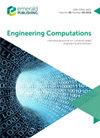Gene expression programming (GEP) as novel tool for thermal analysis and kinetic modeling of pyrolysis reactions: coal pyrolysis case study
IF 1.5
4区 工程技术
Q3 COMPUTER SCIENCE, INTERDISCIPLINARY APPLICATIONS
引用次数: 0
Abstract
PurposeIn this study, a different approach is introduced to generate the kinetic sub-model for the modeling of solid-state pyrolysis reactions based on the thermogravimetric (TG) experimental data over a specified range of heating rates. Gene Expression Programming (GEP) is used to produce a correlation for the single-step global reaction rate as a function of determining kinetic variables, namely conversion, temperature, and heating rate.Design/methodology/approachFor a case study on the coal pyrolysis, a coefficient of determination (R2) of 0.99 was obtained using the generated model according to the experimental benchmark data. Comparison of the model results with the experimental data proves the applicability, reliability, and convenience of GEP as a powerful tool for modeling purposes in the solid-state pyrolysis reactions.FindingsThe resulting kinetic sub-model takes advantage of particular characteristics, to be highly efficient, simple, accurate, and computationally attractive, which facilitates the CFD simulation of real pyrolizers under isothermal and non-isothermal conditions.Originality/valueIt should be emphasized that the above-mentioned manuscript is not under evaluation in any journals and submitted exclusively for consideration for possible publication in this journal. The generated kinetic model is in the final form of an algebraic correlation which, in comparison to the conventional kinetic models, suggests several advantages: to be relatively simpler, more accurate, and numerically efficient. These characteristics make the proposed model computationally attractive when used as a sub-model in CFD applications to simulate real pyrolizers under complex heating conditions.作为热分析和热解反应动力学建模新工具的基因表达编程(GEP):煤热解案例研究
目的 本研究介绍了一种不同的方法,即根据特定加热速率范围内的热重(TG)实验数据,为固态热解反应建模生成动力学子模型。基因表达编程(GEP)用于生成单步全局反应速率与转化率、温度和加热速率等决定性动力学变量之间的相关关系。模型结果与实验数据的比较证明了 GEP 作为固态热解反应建模的强大工具的适用性、可靠性和便利性。研究结果所生成的动力学子模型具有高效、简单、准确、计算量大等特点,有助于对等温和非等温条件下的实际热解器进行 CFD 模拟。所生成的动力学模型的最终形式是代数关联,与传统动力学模型相比,它具有以下几个优点:相对更简单、更准确、数值效率更高。这些特点使得所提出的模型在作为 CFD 应用中的子模型来模拟复杂加热条件下的实际热解器时,具有很强的计算吸引力。
本文章由计算机程序翻译,如有差异,请以英文原文为准。
求助全文
约1分钟内获得全文
求助全文
来源期刊

Engineering Computations
工程技术-工程:综合
CiteScore
3.40
自引率
6.20%
发文量
61
审稿时长
5 months
期刊介绍:
The journal presents its readers with broad coverage across all branches of engineering and science of the latest development and application of new solution algorithms, innovative numerical methods and/or solution techniques directed at the utilization of computational methods in engineering analysis, engineering design and practice.
For more information visit: http://www.emeraldgrouppublishing.com/ec.htm
 求助内容:
求助内容: 应助结果提醒方式:
应助结果提醒方式:


